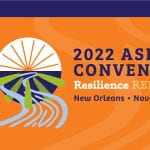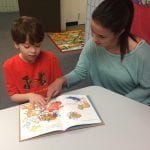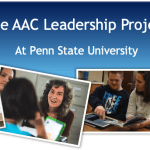Faculty and students presented at ASHA 2022 in New Orleans, LA.
Improving Language and Communication Outcomes for Young Children with Complex Communication Needs
Many children with autism spectrum disorders, cerebral palsy, Down syndrome, and other special needs do not develop speech and language skills as expected; they may have limited speech, they may develop speech late, or they may have speech that is difficult to understand. Without access to speech, these children are severely restricted in the opportunities to express their needs and wants, participate in educational activities, and develop social relationships. There is solid research evidence that demonstrates that AAC offers positive benefits for young children with complex communication needs. Unfortunately most children with complex communication needs do not receive AAC intervention until they are much older and have already missed out on several important years of communication and language learning. The challenge is to investigate early AAC interventions to maximize the language and communication development of infants, toddlers and preschoolers with complex communication needs.
A series of research studies remains on-going to develop effective evidence-based AAC interventions to enhance the language and communication development of infants, toddlers and preschoolers with complex communication needs.
This research centers around two main components of AAC intervention:
• Designing AAC technologies /apps to better meet the needs and skills of young children with complex communication needs
• Teaching partners effective strategies to support the language and communication development of young children with complex communication needs.
We are committed to better understanding the design of AAC technologies /apps for infants, toddlers, and preschoolers, including research to
• Enhance the appeal of AAC technologies /apps for young children
• Decrease the learning demands of AAC technologies /apps for young children
• Increase the communication power of AAC technologies /apps for young children
• Decrease the time and effort required of parents and professionals to program AAC technologies /apps and implement them into the everyday lives of young children.
In addition we are involved in research to teach parents and professionals strategies to effectively support the communication and language development of young children with complex communication needs including strategies such as
• Identify appropriate contexts to support the communication of young children
• Provide the children with effective means to communicate including AAC systems such as signs, low tech symbols/boards, and high tech speech generating devices/ apps
• Select appropriate vocabulary for the children
• Set up the environment to support communication
• Use appropriate interaction strategies to support the children’s communication (e.g., provide lots of opportunities for communication, model use of AAC and speech, wait and allow time for communication, respond to the children’s communicative attempts, have fun)
Since 2014, the research and development projects with the RERC on AAC has been contributing insights into the visual-cognitive processing demands, and the impact of interactive video Visual Scene Displays (VSDs).
Overall, the PSU research supports effective evidence-based AAC intervention for infants, toddlers, and preschoolers with complex communication needs to enhance their language and communication development.
Supporting Peer Interactions for Students With CCN in Inclusive Settings: Paraeducator Roles (McCarty & Light, 2022)
McCarty, T. V. & Light, J. (2022). Supporting peer interactions for students with complex communication needs in inclusive settings; Paraeducator roles. Perspectives of the ASHA Special Interest Groups, 7(1), 229-244. https://doi.org/10.1044/2021_PERSP-21-00141 Purpose This clinical focus article presents a review of literature supporting the importance of fostering positive peer interactions for students with complex communication needs (CCN). A […]
Child-parent-provider interactions in an inpatient rehabilitation facility (Gormley & Light, 2021)
Gormley, J., & Light, J. (2021). Child-parent-provider interactions of a child with complex communication needs in an inpatient rehabilitation facility: A pilot study. American Journal of Speech-Language Pathology, 30(1), 105–118. https://doi.org/10.1044/2020_AJSLP-20-00031 FREE on PubMed Background: Children with complex medical needs often require extensive hospitalizations in the first years of life. Many of these children also experience complex communication […]
Effect of video VSDS on the communicative turns of preschoolers with ASD (Chapin et al., 2021)
Chapin, S.E., McNaughton, D., Light, J., McCoy, A., Caron, J., Lee, D.L. (2021). The effects of AAC video visual scene display technology on the communicative turns of preschoolers with autism spectrum disorder. Assistive Technology, Advance online publication (Full text available) Over 40% of children with autism spectrum disorders (ASD) experience difficulty in using speech. Many children with […]
Effects of shared reading on language and literacy skills of children with ASD (Boyle et al., 2019)
Boyle et al. completed a systematic review to investigate the impact of shared reading on early language and literacy skills for children with ASD.




